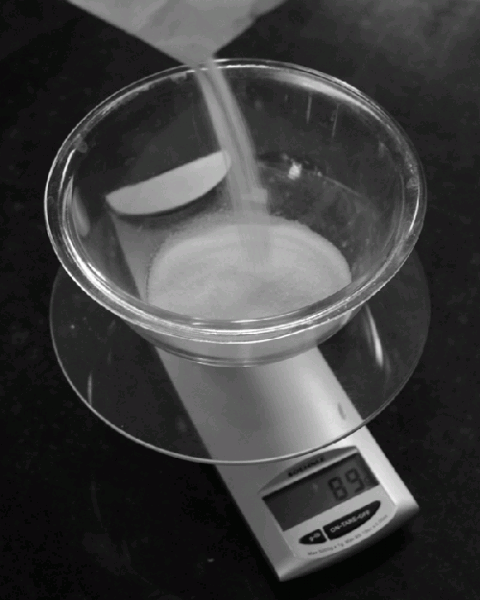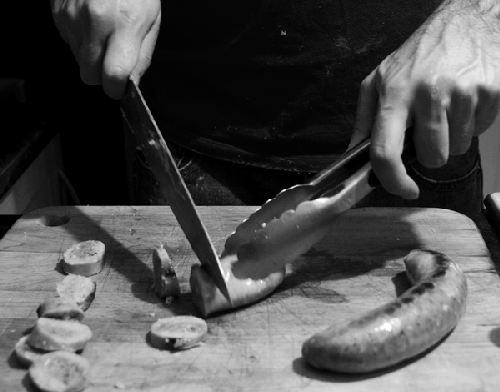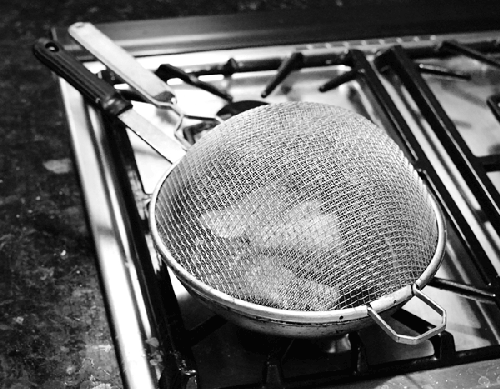OpenSSL Timing Attack Can Intercept Private Keys |
- OpenSSL Timing Attack Can Intercept Private Keys
- Arduino, magnet wire, and Android combine to create poor man's NFC (video)
- Skill Builder: Kitchen Equipment (Part 2)
- NEWS FROM THE FUTURE: Prisoners forced to “gold farm” in virtual worlds
- Samsung Galaxy Tab: Human Outside, Android Inside [Video]
- War Over Arsenic Based Life
- Make a DIY Laptop Sleeve Out of a Pillowcase [Video]
- What Are You Playing This Weekend? [Game Plan]
- New in the Maker Shed: Ultimate Microcontroller Pack
- MeeGo Being Ported To Wayland
| OpenSSL Timing Attack Can Intercept Private Keys Posted: 27 May 2011 03:20 PM PDT Trailrunner7 writes "Remote timing attacks have been a problem for cryptosystems for more than 20 years. A new paper shows that such attacks are still practical ... The researchers, Billy Bob Brumley and Nicola Tuveri of Aalto University School of Science, focused their efforts on OpenSSL's implementation of the elliptic curve digital signature algorithm, and they were able to develop an attack that allowed them to steal the private key of an OpenSSL server." Read more of this story at Slashdot. |
| Arduino, magnet wire, and Android combine to create poor man's NFC (video) Posted: 27 May 2011 03:04 PM PDT Jealous of your Nexus S-owning friends and their fancy NFC chips after yesterday's Google Wallet announcement? Well tech tinkerer Joe Desbonnet has whipped up what he dubs "poor man's NFC" using an Arduino, some magnet wire, and any compass-equipped Android smartphone (which is almost all of them). By placing a coil of wire on the phone and connecting it to the DIYer's favorite microcontroller, Desbonnet was able to send data, albeit very slowly, to his HTC Desire running a special app to decode the signals. Granted, you're probably not going to see American Eagle mod their point of sale systems to talk to your phone's magnetometer, but it's still a neat trick. In fact, we'd break out our Arduino right now to give it a try, but our secret lair is strangely devoid of enameled copper wire. Check out the source link for instructions, and don't miss the video after the break. Continue reading Arduino, magnet wire, and Android combine to create poor man's NFC (video) Arduino, magnet wire, and Android combine to create poor man's NFC (video) originally appeared on Engadget on Fri, 27 May 2011 18:04:00 EDT. Please see our terms for use of feeds. Permalink |  Random Tech Stuff | Email this | Comments Random Tech Stuff | Email this | Comments |
| Skill Builder: Kitchen Equipment (Part 2) Posted: 27 May 2011 03:01 PM PDT
Measuring Cups and ScalesIn addition to the common items used for measuring (e.g., measuring cups and spoons), I strongly recommend purchasing a kitchen scale. If you will be following any of the recipes from this book using hydrocolloids or other food additives (see Chapter 6), it is practically required. You might not use it every day (or even every week), but there is no substitute for it when you need one.
You will obtain better accuracy when measuring by weight. Dry ingredients such as flour can become compressed, so the amount of flour in "1 cup" can vary quite a bit due to the amount of pressure present when it's packed (see the sidebar Weight Versus Volume: The Case for Weight). Also, it is easier to precisely measure weight than volume. Because much of cooking is about controlling chemical reactions based on the ratio of ingredients (say, flour and water), changes in the ratio will alter your results, especially in baking. Weighing ingredients also allows you to load ingredients serially: add 390 grams of flour, hit tare; 300 grams of water, hit tare; 7 grams of salt, hit tare; 2 grams of yeast, mix, let rest for 20 hours, and you've got no-knead bread.
When choosing a scale, look for the following features:
If you plan on following any "molecular gastronomy / modernist cuisine" recipes that use chemicals, you'll need to pick up a high-precision scale that measures in increments of 0.1 gram or finer. I use an American Weigh Scale AMW-100.
Spoons & Co.Few things symbolize cooking more than a spoon, and for good reason: stirring, tasting, adjusting the seasoning, stirring some more, and tasting again would be virtually impossible without a good spoon! I prefer the wooden variety. In an age of technology and modern plastics, there's just something comforting about a wooden spoon. Look for one that has a straight end, as opposed to a traditional spoon shape, because the straight edge is useful for scraping the inside corners and bottom of a pan to release fond. When it comes to cleaning them, I run mine through the dishwasher. True, it's bad for the wood, but I find it easier and don't mind buying a new one every few years. Besides the ubiquitous wooden spoon, here are a few related tools that you should keep "near to hand" while cooking. Silicone Stirring Spatulas Whisks Kitchen Shears Tongs
Thermometers and TimersProbe thermometers are awesome because they use a thermocouple attached to a long heat-safe lead, designed so that you can stick the probe into a piece of meat and set the controller to beep when it reaches the desired temperature. Timers are handy, and if you'll be doing much baking, one will be critical. But if you expect to be doing mostly cooking, a timer is just a proxy for checking when, say, an oven roast has reached temperature, in which case why not use something that actually checks that? And when it comes to food safety, it's not possible to "see" what a hamburger cooked to 160°F / 71°C looks like, even when cut in half. Infrared thermometers are great for taking dry temperatures, such as the surface temperature of a frying pan before you start making pancakes, or ice cream you've just made with liquid nitrogen. The other great thing about them is that they're instant: point, click, done. You can also use them to take the temperature of liquids in a pan without having to worry about handling a hot thermometer probe or washing it after. Keep in mind, though, that stainless steel is reflective in the IR range, just like a mirror reflects visible light—you'll end up taking the temperature of your ceiling, not the pan, if you try to meter an empty stainless steel pan. Also, IR thermometers only take surface temperature, so they shouldn't be used for checking internal temperatures for food safety.
Finally, I'd be remiss if I didn't mention the most overlooked but useful thermometer: your hands. Learn what various temperatures feel like: hold your hand above a hot pan, and notice how far away you can be and still "feel" the heat (thermal radiation). Stick your hand in an oven set to medium heat, remember that feeling, then compare it when you're working with a hot oven. For liquids, you can generally put your hand in water at around 130°F / 55°C for a second or two, but at 140°F / 60°C it'll pretty much be a reflexive "ouch!" Just remember to use a thermometer for foods that need to be cooked to a certain temperature for food safety reasons. Mixing BowlsWhile you can get away with using your dinner plates or soup bowls for holding some things, you'll invariably need mixing bowls for working with and storing your ingredients. I recommend two types: large metal bowls (~12 to 16″ / 30 to 40 cm diameter) and small glass bowls. For metal bowls, poke around your nearest restaurant supply store for some cheap stainless steel ones, which should cost only a few dollars apiece. These bowls are large enough to hold cookie dough, cake batter, and soup, and they have enough room for chopped leafy greens that you plan to sauté. You can also toss them in the oven at low heat to keep cooked items warm, something you can't do with plastic ones. Small glass bowls are also very useful, especially if you're using a mise en place setup. Measuring out chopped ingredients into small glass bowls ahead of time will allow you to toss the ingredients together much faster during the cooking process. If you have leftovers, just wrap the bowls with plastic wrap and store in the fridge. Look for glass bowls that are all the same size and that stack well. You'll often find these bowls available at your local hardware store. Bar TowelsIn addition to wiping off counters with them, you can use bar towels (typically 12″ × 18″ / 30 × 40 cm terry towels with some thickness) as potholders, under a cutting board to prevent slippage, or as a liner in a bowl to help dry washed items such as blueberries or cherries. And you can never have enough of them. I keep several dozen on hand in my kitchen.
Standard Kitchen EquipmentThere is a balance between having the right tool for the right job and having too much stuff on hand. When looking at a potential kitchen tool, consider if you can do the task it's intended for with a tool you already have, and whether the new gizmo is a multitasker capable of solving more than one problem. Storage ContainersWhile you can use consumer-grade plastic containers, the commercial-grade polycarbonate containers used in the restaurant industry are great: they're rugged enough to last a lifetime, can handle hot liquids, and are designed for holding the larger quantities you'll be handling for group cooking. Search online for Cambro's CamSquare containers.
StrainersLook for a strainer that has a metal mesh and a handle long enough to span your sink. Avoid strainers that have plastic parts; plastic isn't as strong or heat resistant and will eventually break. In addition to the normal application of straining cooked foods like pasta or washing berries, a metal strainer can double as a splatter guard when inverted above a frying pan. Depending on the types of food you are cooking, you might find a spider—a specialized spoon with a wide shallow mesh bowl and a long handle—helpful for scooping out items from pots of boiling water.
Mixers & Co.For baking, a handheld mixer or stand mixer is pretty much indispensable. Sure, you can use a whisk or a spoon, but when it comes to creaming together butter and sugar, you'll get better results with an electric mixer that can whip microscopic air bubbles into the mix. Besides a mixer, there are a few other electric devices that are worth their counter space. Immersion Blender Food Processor
Rice Cooker with Slow-Cook Mode UnitaskersI know, I know…unitaskers. Some unitaskers are worth making space for, though, because of how well they perform their particular tasks. Box Grater Pepper Grinder Garlic Press
More:
In the Maker Shed: |
| NEWS FROM THE FUTURE: Prisoners forced to “gold farm” in virtual worlds Posted: 27 May 2011 03:00 PM PDT
NEWS FROM THE FUTURE: Prisoners in lucrative internet gaming work…
|
| Samsung Galaxy Tab: Human Outside, Android Inside [Video] Posted: 27 May 2011 03:00 PM PDT If you're not a nerd, you shouldn't buy an Android tablet. Not yet. This one is just like those, except it's first the one to at least feel like a tablet for real people. More » |
| Posted: 27 May 2011 02:45 PM PDT Antipater writes "Slashdot readers may remember the announcement and ensuing controversy six months ago over the NASA discovery of microbes that can supposedly incorporate arsenic into their DNA. Now, The Washington Post reports that Science has published a collection of eight scathing critiques of astrobiologist Felisa Wolfe-Simon, her methods, and her conclusions. Wolfe-Simon is starting to fire back and gather her own allies — one wonders if we're in for another cold-fusion style science war." Read more of this story at Slashdot. |
| Make a DIY Laptop Sleeve Out of a Pillowcase [Video] Posted: 27 May 2011 02:30 PM PDT Pillowcases are cases, so technically you could just drop your laptop in one of them and be done with it, but here's a way you can actually make a laptop sleeve you'd actually use with just 10-20 minutes of additional work. More » |
| What Are You Playing This Weekend? [Game Plan] Posted: 27 May 2011 02:30 PM PDT Looks like I might be up to my eyeballs in lens flare this weekend if I play some Dungeon Siege III, as I intend to do. There's an Xbox 360 build I haven't gotten to yet, which I shall correct. More » |
| New in the Maker Shed: Ultimate Microcontroller Pack Posted: 27 May 2011 02:23 PM PDT
|
| Posted: 27 May 2011 02:15 PM PDT An anonymous reader writes "From the MeeGo SF2011 conference this week it was disclosed that MeeGo may ship the Wayland Server with the tablet version of the MeeGo 1.3 operating system for release in October." A reasonably annotated version of the presentation slides. Unfortunately video of the talk is not yet available. Read more of this story at Slashdot. |
| You are subscribed to email updates from FEEDcombine: Cool Tools; Download Squad; Engadget; Gizmodo; the How-To Geek; How-To Geek ETC; Kotaku; Lifehacker; Make: Online; Slashdot To stop receiving these emails, you may unsubscribe now. | Email delivery powered by Google |
| Google Inc., 20 West Kinzie, Chicago IL USA 60610 | |







 You can use a bar towel as a potholder to handle dishes or pans that have been in the oven. Fold it in half to double the thickness, and don't use a wet towel because it'll steam up and burn you. Some people prefer oven mitts, because oven mitts are typically thicker and don't have the potential to catch on corners like a towel might.
You can use a bar towel as a potholder to handle dishes or pans that have been in the oven. Fold it in half to double the thickness, and don't use a wet towel because it'll steam up and burn you. Some people prefer oven mitts, because oven mitts are typically thicker and don't have the potential to catch on corners like a towel might.






